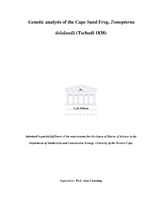| dc.contributor.advisor | Channing, Alan | |
| dc.contributor.author | Wilson, Lyle | |
| dc.date.accessioned | 2016-04-05T13:56:06Z | |
| dc.date.available | 2016-04-05T13:56:06Z | |
| dc.date.issued | 2015 | |
| dc.identifier.uri | http://hdl.handle.net/11394/4866 | |
| dc.description | Magister Scientiae (Biodiversity and Conservation Biology) - MSc (Biodiv and Cons Biol) | en_US |
| dc.description.abstract | Tomopterna delalandii occurs throughout the west coast, Western Cape and south coast of South Africa. This range stretches across three distinct biogeographical assemblages. Based on historical records and the fact that Tomopterna is a genus of cryptic frogs, it is possible that there are unknown genetic variations within the species. To investigate whether population structure is present within T. delalandii a mitochondrial gene and nuclear gene, 16S and Tyrosinase, was sequenced from across the range. Haplotype networks and cladograms were constructed to look
at the relationship between the genetic samples. This revealed definite population structuring between samples from the western edge of the range and samples from the eastern edge of the range. It also revealed that samples taken from the northern edge of the range, while matching general T. delalandii tadpole morphology, are genetically different. Further study needs to be made into the identity of this new form. This study shows that by using both mitochondrial and
nuclear DNA patterns can be discovered about the genetic structure of a species as well as revealing a new one. | en_US |
| dc.language.iso | en | en_US |
| dc.publisher | University of the Western Cape | en_US |
| dc.subject | Tomopterna | en_US |
| dc.subject | Haplotypes | en_US |
| dc.subject | Population structure | en_US |
| dc.subject | South Africa | en_US |
| dc.title | Genetic analysis of the Cape Sand Frog, Tomopterna delalandii (Tschudi 1838) | en_US |
| dc.rights.holder | University of the Western Cape | en_US |

